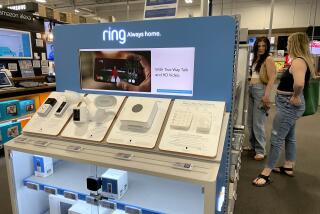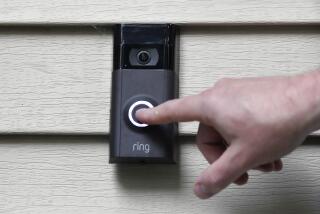The Curse of Complexity
- Share via
LAS VEGAS — Mike Callaghan thought he’d gotten a good deal when he paid $3,200 for a 61-inch Hitachi digital TV.
Nearly $800 later, however, he’s still struggling to make the thing work the way it did in the showroom.
Callaghan’s tale of living-room woe is emblematic of how complex home entertainment gear has become for consumers. Digital technologies have brought high fidelity, great choice and convenience at ever-shrinking prices. But they’ve also been plagued by incompatibility, fickleness, dizzying configurations and endless differences among products.
Electronics manufacturers, which are introducing thousands of new products this week at the Consumer Electronics Show in Las Vegas, say they’re continually working to simplify mat- ters for their customers. But some industry analysts say the situation will get worse before it gets better.
“There are so many new products on the horizon here that there’s a tremendous amount of ... growing pains that have to be gone through before you get to the payoff at the end,” said analyst Michael Goodman of the Yankee Group.
Even such basic steps as connecting a receiver to a monitor can be daunting, as Callaghan recently learned.
In the hands of competing manufacturers, digital technology has become a tool to create a confounding array of formats and specifications--and a befuddling lack of standardization.
Callaghan, a Charleston, W. Va., general manager for a manufactured-housing company, bought the Hitachi TV set for its finely detailed picture and cinema-quality sound. Like other “high definition ready” products, though, the Hitachi can’t display an HDTV picture unless it’s connected to a digital receiver, which is sold separately.
After buying an RCA DirecTV receiver for $550, he discovered that its HDTV plug fit only RCA TVs. He also learned that only one wire from a satellite dish could connect to the receiver, but he had two dishes on his roof--one for regular DirecTV programming, the other for HDTV channels. He found an adapter online to connect the receiver to the TV, but he’s still waiting for the special box he needs to merge the two dishes into a single feed.
“IQs don’t help a lot,” Callaghan said of his dilemma. “This is a different animal.”
Callaghan’s problems stem from a common shortcoming in the world of digital home-entertainment gear: the lack of a standard way to connect devices.
Analyst Richard Doherty of the Envisioneering Group, a technology research and consulting firm, blames legal disputes and corporate greed for the proliferation of connectors. Companies developed and patented techniques for linking devices, injecting competition into an arena where consumers long for a standard approach.
For example, digital TV monitors use at least five incompatible plugs and sockets to connect to digital receivers. The field probably will narrow to two types of digital connectors that Hollywood favors, but the vast majority of the “HDTV ready” models sold today don’t have either.
And every time manufacturers migrate to a new connector for better fidelity, picture quality or security, consumers with older devices find themselves, like Callaghan, searching for an adapter.
Companies are trying to make things simpler and easier for consumers, said Thomson spokesman Dave Arland. “But at the same time, there’s an engineering effort to make yourselves different from everybody else,” he added.
The situation isn’t helped by the proliferation of boxes in the living room, some connecting to the TV set, some to the stereo and some to both. Many consumers are confounded by the limits that these boxes place on each other for no apparent reason--a digital satellite receiver that wipes out a TV’s picture-in-picture feature, say, or a digital cable box that can’t change channels on the VCR.
A host of other factors is increasing the complexity of home entertainment devices.
Incompatible formats
Although digital data boils down to a common language of ones and zeros, companies have developed dozens of ways to package, compress, store and transmit that information. Each format has its adherents, splintering manufacturers into rival camps backing different standards.
For example, just because a compact disc has songs or a movie on it, that doesn’t mean your CD or DVD player can play it. There are three types of CDs, six types of DVDs and more than a dozen ways of encoding music or video on them. Each type may be unrecognizable to a disc player that doesn’t have the right technology.
Perhaps the most common complaint is that manufacturers use a unique remote control for almost every device they make. Instead of having a standard set of infrared commands for adjusting the volume on a TV and changing the channel on a cable box, manufacturers use different electronic codes even within the same brand.
Jeff Cove, a merchandising vice president for Panasonic Consumer Electronics Co., said things were different in the analog world because many of those standards were physical or mechanical. “In an electronic world, you can make standard after standard built on digital [technology],” Cove said. “It is so easy to create a standard, or a way of doing things, that the bent is toward creating [more] standards.”
Instability
In sharp contrast to computers, consumer electronics had a long history of reliability, said Jakob Nielsen, a consultant who specializes in how people relate to technology. But those devices have grown increasingly reliant on software, which is vulnerable to inexplicable breakdowns and internal conflicts.
Nielsen said his wireless telephone stopped ringing the other day for no apparent reason, forcing him to reboot it.
“That’s just unacceptable that we have that level of problems in consumer electronics,” he said.
With digital technology, manufacturers can make their devices highly customizable and programmable--far more than they could with analog gear.
For example, while turntables can simply spin records, CD players can simulate the acoustics of a concert hall or a jazz club, play tracks at random, fast-forward to specific passages or repeat selected portions of songs.
Feature overload
Consumers may welcome extra functions. But some products, such as camcorders and digital cameras, mystify shoppers with a bevy of minor differences between brands, said Bentley Nelson of Maxtor Corp., a leading manufacturer of disk drives.
“I think a lot of electronics products are driven by engineers,” said Nelson, a consumer-electronics marketing executive at Maxtor. “And engineers know what they can make the products do.”
Another explanation, Goodman of the Yankee Group said, is that many digital product lines are still early in their development. “The first thing is you add new features and new devices, and this makes things more complex. As time goes on ... consumer companies begin to simplify how the devices work and how they connect to each other,” he said.
Piling on features once was just as big a problem in the analog world, Cove of Panasonic said. For instance, he said, “We used to be able to make hi-fi receivers with 1,000 buttons on them.”
Overwhelming choices
Not only have features proliferated, but so have the technologies used to make home-entertainment products.
Television sets are a good example. In the past, every set was built around a cathode ray tube. Today, you’ll also find plasma, digital light projection, liquid crystal display and liquid crystal on silicon.
As a consequence, consumers can’t just compare features, said Bob Scaglione, a market vice president for Sharp Consumer Electronics. Now they need to compare technologies.
The same issue applies to programming, where digital cable, satellite TV and the Internet have created a virtually endless supply. Although it’s a richer world than the one of bygone years, with three major networks and a few independent stations, it’s also a harder one to navigate.
Cable and satellite operators have improved the situation with electronic program guides that consumers can search through or organize by genre. Still, the program guides need to become more intuitive, learning a user’s preferences and describing programs with video instead of text, said Mark Samuel, a marketing director at Philips Semiconductors, which supplies microprocessors for set-top boxes.
Consumer-electronics executives say the public wants the extra features, choices and control that digital brings. “Not everything can be simple, but if it’s logical and it works, I think that’s a better approach than just trying to make it easy,” Scaglione said
Besides, more than half the homes in the United States have computers, and nothing in consumer electronics comes close to the complexity of a PC, said Larry Gerbrandt, chief content officer for the Kagan World Media research firm.
“We’ve actually trained a generation of people in how to hook things up and make software run,” Gerbrandt said.
“We’ll look back 20 years from now [at today’s devices] and say, ‘Piece of cake.’”
For example, Thomson has human-behavior researchers visit consumers’ homes to ask what they want and expect from products. These sessions have persuaded Thomson to present its products’ features in layers. Users see the basic functions first, but have to dig deeper to find the advanced ones, said Megan Brown, Thomson’s worldwide manager of user-interface design and research.
Still, some industry executives and analysts warn that products are about to become significantly more complex. The Next Big Thing in consumer electronics is hooking stereos, TVs and computers together in a home network.
Voicing a common sentiment, Samuel of Philips said, “Trying to set up a home network is about the biggest nightmare you could undertake.”
*
Jon Healey covers the convergence of entertainment and technology. He can be reached at jon.healey@latimes.com.







